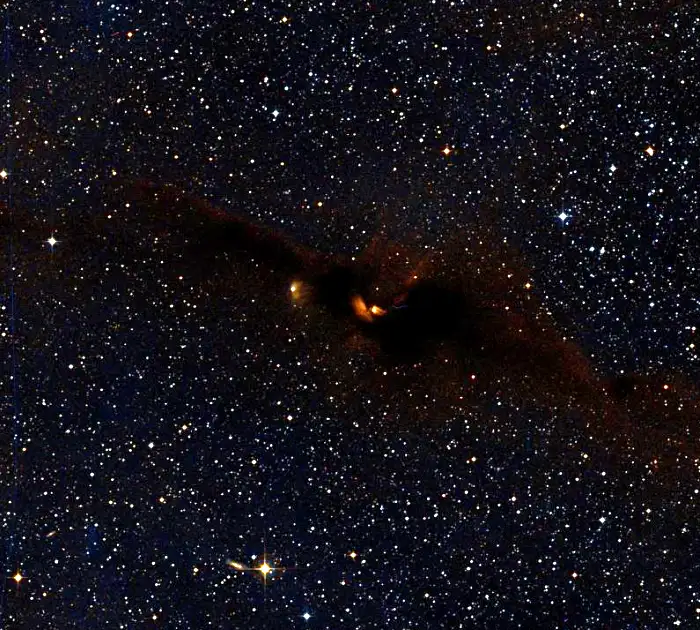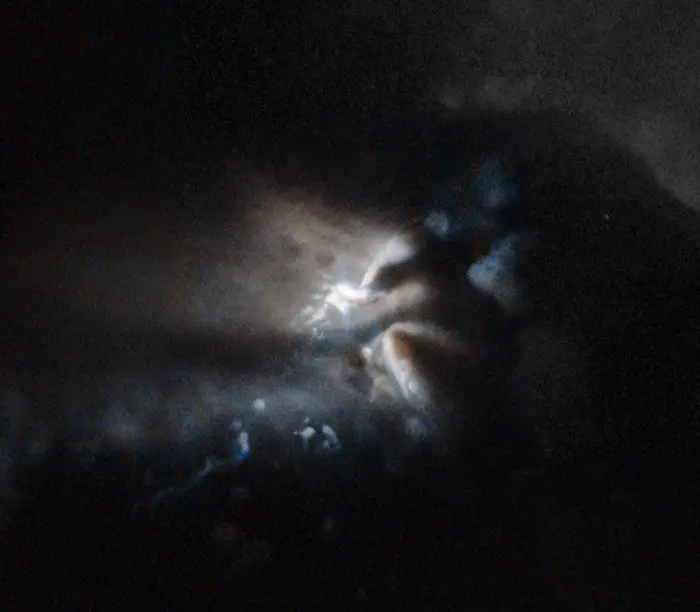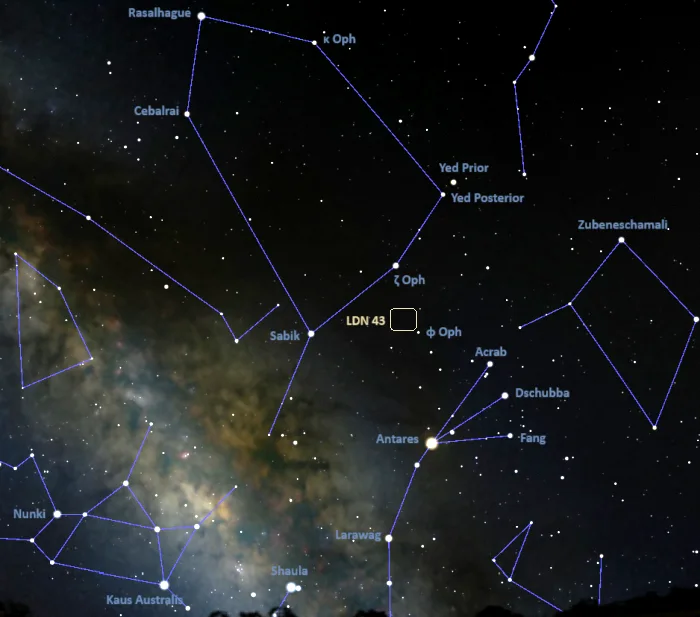The Cosmic Bat Nebula (LDN 43) is a dark nebula located approximately 1,400 light-years away in the constellation Ophiuchus. Stretching about 12 light years across, the elongated cloud of dust and gas is a stellar nursery. The bright regions in the nebula are dense gaseous knots in which young stars form.
LDN 43 was nicknamed the Cosmic Bat because the clouds of dark nebulosity resemble a flying bat. The designation LDN 43 comes from the Lynds Catalogue of Dark Nebulae, compiled by the American astronomer Beverly Turner Lynds in 1962 based on images obtained with the 48-inch Schmidt telescope as part of the National Geographic Society-Palomar Observatory Sky Survey.
Dark nebulae are cosmic objects that are dense enough to block the light of objects in the background. These interstellar clouds contain cold, dense interstellar dust grains that absorb the visible light from any background stars, emission or reflection nebulae, star clusters and galaxies.

Cosmic Bat Nebula, image credit: ESO/Digitized Sky Survey 2 (CC BY 4.0)
Also known as absorption nebulae, dark nebulae are typically dense molecular clouds containing tiny dust particles coated with frozen carbon monoxide and nitrogen, which block the passage of light at visible wavelengths. Dark nebulae also typically contain molecular hydrogen, atomic helium and other compounds that do not absorb visible light.
The Cosmic Bat Nebula frames the reflection nebula LBN 7 and obscures its light. LBN 7 appears as illuminated dust in the background of the dark nebula. Another background object, the galaxy LEDA 3868080, appears near the Cosmic Bat. The galaxy lies approximately 400 million light years away. With a diameter of 130,000 light-years, it is larger than our own Milky Way galaxy.
LDN 43 contains two cometary nebulae, catalogued as GN 16.31.3 and GN 16.31.7. GN 16.31.7 is the brightest yellow patch near the centre of the Cosmic Bat. It is lit by the young T Tauri star RNO 91. GN 16-31.3 is associated with another T Tauri star, RNO 90. These young stellar objects are members of the Upper Scorpius association, a subgroup of the larger Scorpius-Centaurus association, the nearest OB association to the Sun. The average age of the association members is only 11 million years.

Don’t be fooled by the title; the mysterious, almost mystical bright light emerging from these thick, ominous clouds is actually a telltale sign of star formation. Here, a very young star is being born in the guts of the dark cloud LDN 43 — a massive blob of gas, dust, and ices. Stars are born from cosmic dust and gas, which floats freely in space until gravity forces it to bind together. The hidden newborn star in this image, revealed only by light reflected onto the plumes of the dark cloud, is named RNO 91. It is what astronomers call a pre-main sequence star, meaning that it has not yet started burning hydrogen in its core. The energy that allows RNO 91 to shine comes from gravitational contraction. The star is being compressed by its own weight until, at some point, a critical mass will be reached and hydrogen, its main component, will begin to fuse together, releasing huge amounts of energy in the process. This will mark the beginning of adulthood for the star. But even before this happens the adolescent star is bright enough to shine and generate powerful stellar winds, emitting intense X-ray and radio emission. RNO 91 is a variable star around half the mass of the Sun. Astronomers have been able to observe the existence of a dusty, icy disc surrounding it, stretching out to over 1700 times the distance from Earth to the Sun. It is believed that this disc may host protoplanets — planets in the process of being formed — and will eventually evolve into a fully-fledged planetary system. This image is based on data gathered by the NASA/ESA Hubble Space Telescope. A version of this image was entered into the Hubble’s Hidden Treasures image processing competition by contestant Judy Schmidt. Image credit:ESA/Hubble & NASA; Acknowledgement: Judy Schmidt (CC BY 3.0)
LDN 43 is not the only bat in the sky. The faint emission nebula Sh2-129 in the northern constellation Cepheus is known as the Flying Bat Nebula. The Veil Nebula, a large supernova remnant in Cygnus (the Swan), contains a region of ionized gas nicknamed the Bat Nebula and catalogued as IC 1340. The reflection nebula NGC 1788 in Orion is sometimes also called the Cosmic Bat.
Location
The Cosmic Bat Nebula lies in the southern part of the constellation Ophiuchus, near the border with Scorpius. It appears about a quarter of the way from Zeta Ophiuchi to Antares. Zeta Ophiuchi appears at the base of the large polygon that dominates Ophiuchus, and the bright Antares appears between two distinctive asterisms, the Scorpion’s claws and the Fish Hook.
The Cosmic Bat appears near the yellow giant Phi Ophiuchi (mag. 4.27), which is faintly visible from areas without too much light pollution. The nebula lies in the same region of the sky as the Blue Horsehead Nebula and the Rho Ophiuchi cloud complex.
At declination -15° 47’, the nebula never rises for observers north of the latitude 74° N.

Location of the Cosmic Bat Nebula (PDN 43), image: Stellarium
Cosmic Bat Nebula – LDN 43
| Constellation | Ophiuchus |
| Object type | Dark nebula |
| Right ascension | 16h 34m 29.3s |
| Declination | -15° 47’ 11’’ |
| Apparent size | 0.07 square degrees |
| Distance | 1,400 light-years (429 parsecs) |
| Size | 12 light years |
| Names and designations | Cosmic Bat Nebula, Bat Signal Nebula, LDN 43 |